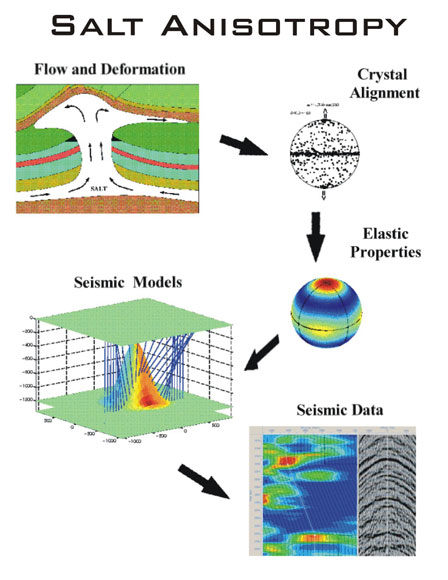

Salt Anisotropy
Hydrocarbons in the vicinity of salt structures continue to be somewhat elusive exploration targets. It is not uncommon, even in mature areas, for wells to miss sub-salt targets by wide margins. Part of the difficulty is associated with the highly three-dimensional nature of salt bodies and the large velocity contrasts between the salt and surrounding sedimentary layers. Although salt has very high seismic velocities, it is very buoyant and deformable which allows it to flow upwards and laterally with ease. An important consequence of such flow is that the constituent crystals within the salt body can align, thereby generating an effective seismic anisotropy. In this research we consider the potential for such anisotropy, attempt to quantify the levels of anisotropy in a large salt body in the Gulf of Mexico and, finally, assess the ramifications of neglecting such anisotropy in seismic processing. Our approach links numerical modelling of salt deformation and anisotropy with seismic modelling to assess to consequences of such anisotropy. We have also looked for these effects in a variety of seismic datasets acquired in salt environments.

Industry Collaboration
- Shell International Exploration and Production - Rijswijk, Netherlands
- Total GRC - UK
- BP - Houston, Texas; Stavenger, Norway.
Publications
- Raymer, D. G., J-M. Kendall, D. Pedlar, R. R. Kendall, M. C. Mueller and G. J. Beaudoin, 2000, The significance of salt anisotropy in seismic imaging, Proceedings of 70th Annual Int. Meeting of the Soc. Explor. Geophys. , Calgary.
- Raymer, D. G., J-M. Kendall, D. Pedlar, R. R. Kendall, M. C. Mueller and G. J. Beaudoin, 2000, Seismic anisotropy in salt bodies: implications for seismic imaging, proceedings of 62th EAGE Conference & Technical Exhibition, Glasgow, Scotland, C-13(i-iv).
- Raymer, D. G., A. Tommasi and J-M. Kendall, 2000, Predicting the seismic implications of salt anisotropy using numerical simulations of halite deformation, Geophysics , 65 , 1272-1280.
- Raymer, D. G., J-M. Kendall, G. J. Beaudoin, M. C. Mueller and R. R. Kendall, 1999, Measuring the anisotropy of salt in the Mahogany oil field, Gulf of Mexico, Proceedings of the AAPG International Conference, Birmingham, 100-103.
- Raymer, D. G., J-M. Kendall and J. Beaudoin, 1999, Measurements of salt anisotropy: calculating Thomsen's \delta parameter in real and synthetic data, Proceedings of 69th Ann. Int. Mtg., Soc. Explor. Geophys., Expanded Abstracts , Houston, 1596-1600.
- Raymer, D. G., A. Tommasi and J-M. Kendall, Predictions of salt anisotropy from numerical simulations of deformation and its seismic implications, Proceedings of 68th Annual Int. Meeting of the Soc. Explor. Geophys., New Orleans, 600-604, 1998.
- Raymer, D. G. and J-M. Kendall, Seismic anisotropy in salt structures due to preferred crystal orientation, La Revue de l'IFP, 53, 35-43, 1998.
- Raymer, D. G. and J-M. Kendall, 1997, Potential pitfalls in imaging salt structures due to preferred crystal orientation and seismic anisotropy, proceedings of the 67th Annual Int. Meeting of the Soc. Expl. Geophys., Dallas, TX, SP6.8, 1254-1257.